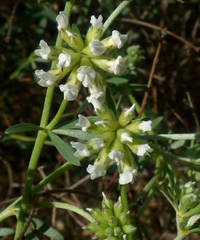Field marigold
Calendula arvensis
Calendula arvensis, commonly known as Field Marigold or locally as Caléndula silvestre, is a species of flowering plant belonging to the Asteraceae family. It is native to southern Europe but has spread to other parts of the world, including the Comunidad Valenciana, where it thrives in the sunny, Mediterranean climate.
Characteristics:
- Appearance: Calendula arvensis is an annual herbaceous plant that can grow up to 50 cm in height. It typically features hairy, branched stems with alternate, lanceolate leaves.
- Flowers: The plant is distinguished by its bright orange to yellow, daisy-like flowers. Each flower head is composed of several ray florets surrounding a cluster of central disc florets.
- Blooming Season: It blooms from early spring to late autumn, providing vibrant color across fields and meadows.
Habitat:
- Calendula arvensis is commonly found in open, sunny locations such as fields, roadsides, and wastelands.
- It prefers well-drained soils and can often be seen thriving in disturbed areas.
Ecological Importance:
- The Field Marigold is important for local ecosystems as it attracts pollinators, including bees and butterflies, due to its vivid flowers.
- It plays a role in soil stabilization and can contribute to increasing the biodiversity of an area.
In the Comunidad Valenciana, the Field Marigold is appreciated not only for its ecological role but also for its beauty and the bright splash of color it adds to the region's diverse landscapes.







